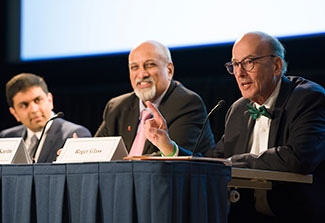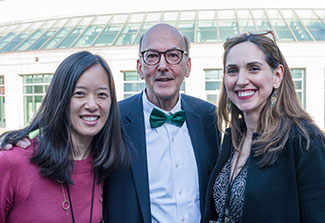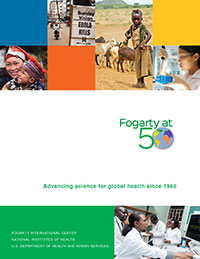
Fogarty at 50: Considering the new frontiers of global health research
May / June 2018 | Volume 17, Number 3

Photo by Andrew Propp for Fogarty/NIH
The Fogarty family came together May 1 to mark the Center’s
50th birthday. From left, Drs. Vivek Naranbhai, Slim Abdool
Karim and Roger Glass.
50th birthday. From left, Drs. Vivek Naranbhai, Slim Abdool
Karim and Roger Glass.
Opinion by Fogarty Director Dr Roger I Glass
As we mark our 50th year, it is appropriate that we both celebrate our many accomplishments and consider how best to tackle the new global health challenges of the 21st century. Fogarty has had a rich and varied legacy since its establishment in 1968. In our first decade, our infancy, Fogarty served as a conference center for global health policy discussions and a convener of outstanding scientists from around the world to build collaborations with U.S. investigators.
In the 1980s, as the extent of the global HIV/AIDS epidemic became clear, we began our first institutional extramural grant program, the AIDS International Training and Research Program, or AITRP. Fogarty developed a model of partnering U.S. and foreign institutions in low- and middle-income countries to train the next generation of young investigators, to build a research base in areas where this was lacking, with the infrastructure required to conduct ethical, groundbreaking research.

Photo by Andrew Propp for Fogarty/NIH
Center Director Dr. Roger I. Glass greeted
former Fogarty fellows during the anniversary
celebration.
former Fogarty fellows during the anniversary
celebration.
This approach has become the hallmark of Fogarty programs - taking science where the problems are and building local research capacity to solve them. The scientists who were first trained through our programs have become world leaders on the front lines in the battle to staunch the global epidemic of HIV/AIDS through innovative research, in collaboration with U.S. investigators, and with additional support from many others at NIH and beyond. The return on investment in people, partnerships and policies has truly changed the world.
More recently, this model has been extended beyond infectious diseases to chronic, noncommunicable diseases and disciplines critical to advancing the global health agenda from every specialty of the medical and health sciences - including areas not traditionally considered part of global health, such as economics, law, business, architecture, engineering and others.
Fogarty remains the smallest center at NIH with what is perhaps the broadest goal - investing to build the next generation of leaders in biomedical research and supporting training to make them productive collaborators who can contribute to discoveries that improve health globally, as well as in the U.S.
To mark our anniversary, we’ve compiled profiles of some of our most successful trainees and captured stories that demonstrate the value of Fogarty programs in a new book, Fogarty at 50: Advancing science for global health since 1968. These are just a few examples that illustrate the impact of Fogarty programs and represent hundreds of others. I hope you will spend some time perusing this book and emerge as moved as I am by all we have accomplished together.
For the last 50 years, Fogarty’s focus has been on cultivating partnerships that advance science for global health. On behalf of all of our staff and our alumni, we thank you for your continued support.
More Information
To view Adobe PDF files, download current, free accessible plug-ins from Adobe's website .






















.png)









No hay comentarios:
Publicar un comentario